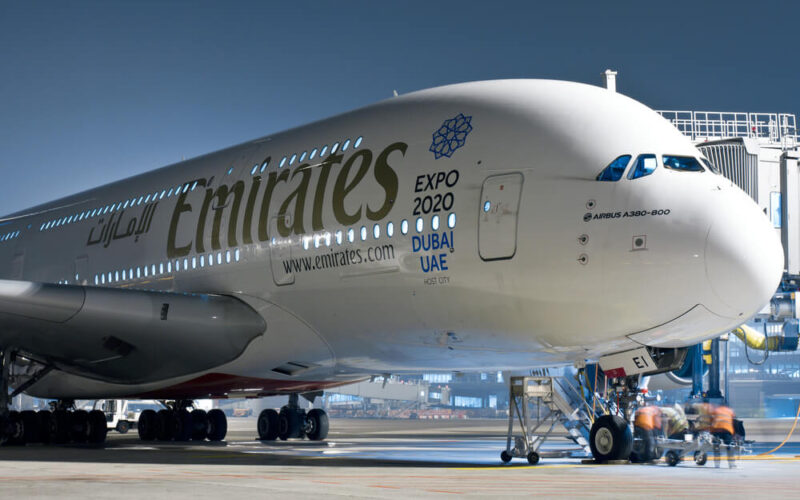Emirates is arguably one of the most prestigious airline brands in the world. The airline not only tries its best to attract customers by the one-of-a-kind luxury onboard its aircraft, but also by very aggressive branding throughout various events, including the World Expo that is set to be hosted in Dubai, United Arab Emirates, the home of the carrier.
The airline group managed to achieve a profit for 32 years in a row, out of its total 35 years of existence. Despite consecutive profits, though, the airline has showcased troubling signs since its peak in FY2016, when its profit margins dropped to 1.5% in FY2017, a fall of 6.9%.
Newest results, published on May 11, 2020, indicate that its profit margins have barely stayed afloat, as Emirates managed to reach a 1.1% margin. In total, the airline reported a profit of $288 million (AED1.1 billion), an increase of $51 million compared to the previous year. However, Emirates’ revenues took a hit, as such events like the Dubai International Airport (DX) runway closure and the decision to suspend flights at the end of the airline’s financial year in March 2020.
But this could only be the beginning of a long and bloody uphill battle. As the COVID-19 pandemic has sent the world into lockdown, the outlook for air travel looks grim. Executives, ranging from the manufacturers to airlines, are predicting that 2019 levels of travel are only set to return in a couple of years’ time. For an airline like Emirates, that has only grown massively in terms of its fleet size and the capacity, the post-coronacrisis world could be a difficult situation to manage.
Wide-body and proud
Emirates is one of the few all-wide-body airlines in the world. The two-type Airbus A380 and Boeing 777 operator stands proud of its fleet, as it highlighted in its latest results’ report. It is both the largest customer of the Airbus A380 and the Boeing 777. But both, are seemingly singing their swan songs – the company has orders for 50 Airbus A350 and 30 Boeing 787 Dreamliner aircraft, both of which are set to join the Emirates’ fleet starting from 2023.
While it is certainly an impressive feat to upkeep such a fleet and still post a profit even during the most troubling times, including the post-9/11 shock and the difficulties that the global economy faced following the financial crisis of 2008, the coronavirus-induced health and financial crisis is no repetition of those downturns in aviation. Passengers now question whether traveling is safe. Business travelers, on the other hand, are forced to talk to their partners on various conferencing platforms, questioning not only the ability to make sales over the internet but also to unmute their microphones.
While there will come a point in the short-future whereupon travel will pick up again, with some factors indicating that the rock bottom for demand was mid-April 2020, it is most likely to be domestic travel that would recover first. Omer Rabin, the managing director of Guesty, a property management software company for home rental businesses, told CNBC.com that there “will be a lot of demand for domestic travel.” Another hospitality executive, Alan X. Reay told the Los Angeles Times that the hotels that are within driving distance are going to recover the fastest, as people are “reluctant to travel by plane.”
The world is seeing another phenomenon – travel bubbles. Australian and New Zealander governments agreed to establish air links between the two countries when it is safe to do so. The three Baltic states, namely Estonia, Latvia and Lithuania, will allow their citizens to cross the three borders starting on May 15, 2020.
But travel bubbles are not the answer to Emirates’ problems when the airline has huge bills to pay in regards to its financial obligations. The Dubai flag carrier’s lease liabilities in the next financial year is set to be $3 billion (AED11.3 billion), without including the bonds and terms that account for a further $3.3 billion (AED12.3 billion). Its saving grace, of course, is the Dubai government – the owner of the airline. It has pledged to support the airline during a difficult period.
And there is a good reason why it did so.
Reliance on aviation
The United Arab Emirates, including Dubai, is stereotypically known as an oil-rich region that relies on black gold to fund the Emirate’s exuberant lifestyle. However, Dubai has diversified its economy in order not to put all of its eggs in one basket. Without getting into the nitty-gritty, aviation and tourism-related activities are crucial to the region. Air transport commercial services exports and travel-related exports made up 15.9% and 8.2% of the total nominal Gross Domestic Product (GDP) of Dubai, respectively, stated the Government of the Emirate in its latest economic report.
If these services were to abruptly stop, the Emirate risks losing a fifth of its total GDP in one clean sweep. Furthermore, an economic study that quantified the economic impact of aviation in Dubai, conducted by Oxford Economics and published in November 2014, predicted that the aviation sector, directly and indirectly, would contribute 44.7% to the economy of Dubai, including 35.1% of total jobs in the city.
A crumbling Emirates airline would also mean a crumbling Dubai, without even including the fact that the city would lose a major part of its connections to the outside world. However, Emirates declaring bankruptcy is hardly an imaginable scenario. A perfect example could be its next-door neighbor, Etihad – an airline based in nearby Abu Dhabi has managed to survive despite its financial results showcasing billions of losses over the past four years.

